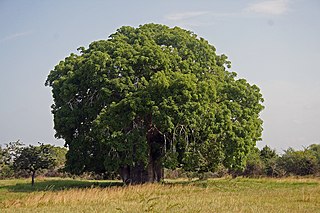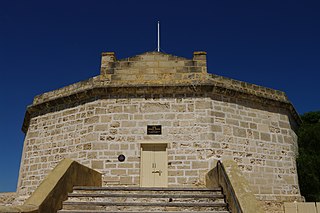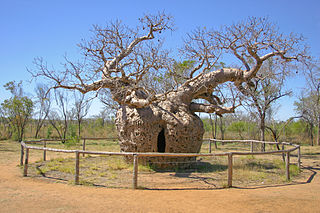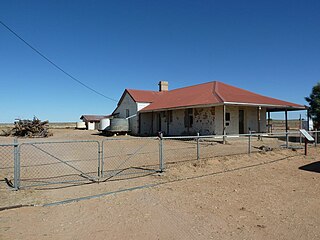
Adansonia is a genus made up of eight species of medium-to-large deciduous trees known as baobabs. They are placed in the Malvaceae family, subfamily Bombacoideae. They are native to Madagascar, mainland Africa, and Australia. The trees have also been introduced to other regions such as Asia. The generic name honours Michel Adanson, the French naturalist and explorer who described Adansonia digitata. The baobab is also known as the "upside down tree", a name that originates from several myths. They are among the most long-lived of vascular plants and have large flowers that are reproductive for a maximum of 15 hours. The flowers open around dusk, opening so quickly that movement can be detected by the naked eye, and are faded by the next morning. The fruits are large, oval to round and berry-like and hold kidney-shaped seeds in a dry, pulpy matrix.

Adansonia gregorii, commonly known as the boab and also known by a number of other names, is a tree in the family Malvaceae, endemic to the northern regions of Western Australia and the Northern Territory of Australia.

Sir Augustus Charles Gregory was an English-born Australian explorer and surveyor. Between 1846 and 1858 he undertook four major expeditions. He was the first Surveyor-General of Queensland. He was appointed a lifetime Member of the Queensland Legislative Council.

Joseph Johns, better known as Moondyne Joe, was an English convict and Western Australia's best-known bushranger. Born into poor and relatively difficult circumstances, he became something of a petty criminal robber with a strong sense of self-determination. He is remembered as a person who had escaped multiple times from prison.
Bottle tree or bottle-tree may refer to:

Wyndham is the northernmost town in the Kimberley region of Western Australia, on the Great Northern Highway, 2,210 kilometres (1,373 mi) northeast of Perth. It was established in 1886 to service a new goldfield at Halls Creek, and it is now a port and service centre for the east Kimberley with a population of 941 as of the 2021 census. Aboriginal and Torres Strait Islander people make up 54% of the population. Wyndham comprises two areas - the original town site at Wyndham Port situated on Cambridge Gulf, and 5 kilometres (3.1 mi) by road to the south, the Three Mile area with the residential and shopping area for the port, also founded in 1886. Wyndham is part of the Shire of Wyndham-East Kimberley.

Daniel Kelly was an Australian bushranger and outlaw. The son of an Irish convict, he was the younger brother of the bushranger Ned Kelly. Dan and Ned killed three policemen at Stringybark Creek in northeast Victoria, near the present-day town of Tolmie, Victoria. With two friends, Joe Byrne and Steve Hart, the brothers formed the Kelly Gang. They robbed banks, took over whole towns, and kept the people in Victoria and New South Wales frightened. For two years the Victorian police searched for them, locked up their friends and families, but could not find them. Dan Kelly died during the infamous siege of Glenrowan.

The Round House was the first permanent building built in the Swan River Colony. Built in late 1830 and opened in 1831, it is the oldest building still standing in Western Australia.

Adansonia digitata, the African baobab, is the most widespread tree species of the genus Adansonia, the baobabs, and is native to the African continent and the southern Arabian Peninsula. These are long-lived pachycauls; radiocarbon dating has shown some individuals to be over 2,000 years old. They are typically found in dry, hot savannas of sub-Saharan Africa, where they dominate the landscape and reveal the presence of a watercourse from afar. They have traditionally been valued as sources of food, water, health remedies or places of shelter and are a key food source for many animals. They are steeped in legend and superstition. In recent years, many of the largest, oldest trees have died, possibly due to climate change. Common names for the baobab include monkey-bread tree, upside-down tree, and cream of tartar tree.

The Perth Gaol was a gaol built in Perth, the state capital of Western Australia, between 1854 and 1856 to house convicts and other prisoners. It is located just west of Beaufort Street.

The Wentworth Gaol is a heritage-listed former gaol and school building and now museum and old wares shop located at 112 Beverley Street, Wentworth, in the Wentworth Shire, New South Wales, Australia. It was designed by James Barnet and built from 1879 to 1881 by Whitcombe Brothers, Hay. It is also known as the Old Wentworth Gaol. The property is owned by Department of Primary Industries - Western Lands Commissioner, an agency of the Government of New South Wales. The property was added to the New South Wales State Heritage Register on 21 October 2016.

Arborglyphs, dendroglyphs, silvaglyphs, or modified cultural trees are carvings of shapes and symbols into the bark of living trees. Although most often referring to ancient cultural practices, the term also refers to modern tree-carving.

Adansonia grandidieri is the biggest and most famous of Madagascar's six species of baobabs. It is sometimes known as Grandidier's baobab or the giant baobab. In French it is called Baobab malgache. The local name is renala or reniala. This tree is endemic to the island of Madagascar, where it is an endangered species threatened by the encroachment of agricultural land. This is the tree found at the Avenue of the Baobabs.
The Forrest River massacre, or Oombulgurri massacre of June 1926, was a massacre of Indigenous Australian people by a group of law enforcement personnel and civilians in the wake of the killing of a pastoralist in the Kimberley region of Western Australia.
The Old Kilmore Gaol is a bluestone building in Kilmore, Victoria. It was originally built as a gaol and is located at 8 to 12 Sutherland Street.

The Baobab Prison Tree, Derby is a 1,500-year-old, large hollow Adansonia gregorii (Baobab) tree 6 kilometres south of Derby, Western Australia with a girth of 14.7 metres. It had been reputed to have been used in the 1890s as a lockup for indigenous Australian prisoners on their way to Derby for sentencing, but there is no evidence that it was ever used to house prisoners.
Timber Creek, traditionally known as Makalamayi, is an isolated small town on the banks of the Victoria River in the Northern Territory of Australia. The Victoria Highway passes through the town, which is the only significant settlement between the Western Australia border and the town of Katherine to the east. Timber Creek is approximately 600 kilometres (370 mi) south of Darwin, in an area known for its scenic escarpments and boab trees.

Elizabeth Grant CF was an Australian architectural anthropologist, criminologist and academic working in the field of Indigenous Architecture. She was a Churchill Fellow and held academic positions at The University of Adelaide, as Associate Professor of Architecture and Urban Design at RMIT University's RMIT School of Architecture and Design, Adjunct Professor at the University of Canberra and the University of Queensland. She researched, wrote, and was an activist focused on architecture and design with Indigenous peoples as architectural practice and a social movement, and the observance of human rights in institutional architecture. Her expertise in Indigenous housing and homelessness, design for Indigenous peoples living with disability, and indigenising public places and spaces made her a regular guest on the Australian Broadcasting Corporation's Radio National and ABC Local Radio. She wrote and reviewed architectural projects for architectural magazines such as Architecture Australia, the journal of the Australian Institute of Architects, and the Australian Design Review.

A jail tree is any tree used to incarcerate a person, usually by chaining the prisoner up to the tree. Jail trees were used on the American frontier in the Territory of Arizona, in the late 19th and early 20th centuries; jail trees were also used in Australia. A few jail trees survive to this day.

Birdsville Courthouse is a heritage-listed courthouse at Adelaide Street, Birdsville, Shire of Diamantina, Queensland, Australia. It was designed by the Queensland Department of Works and built from 1888 to 1890 by J Wookey and Henry Walton. It was added to the Queensland Heritage Register on 21 October 1992.
















